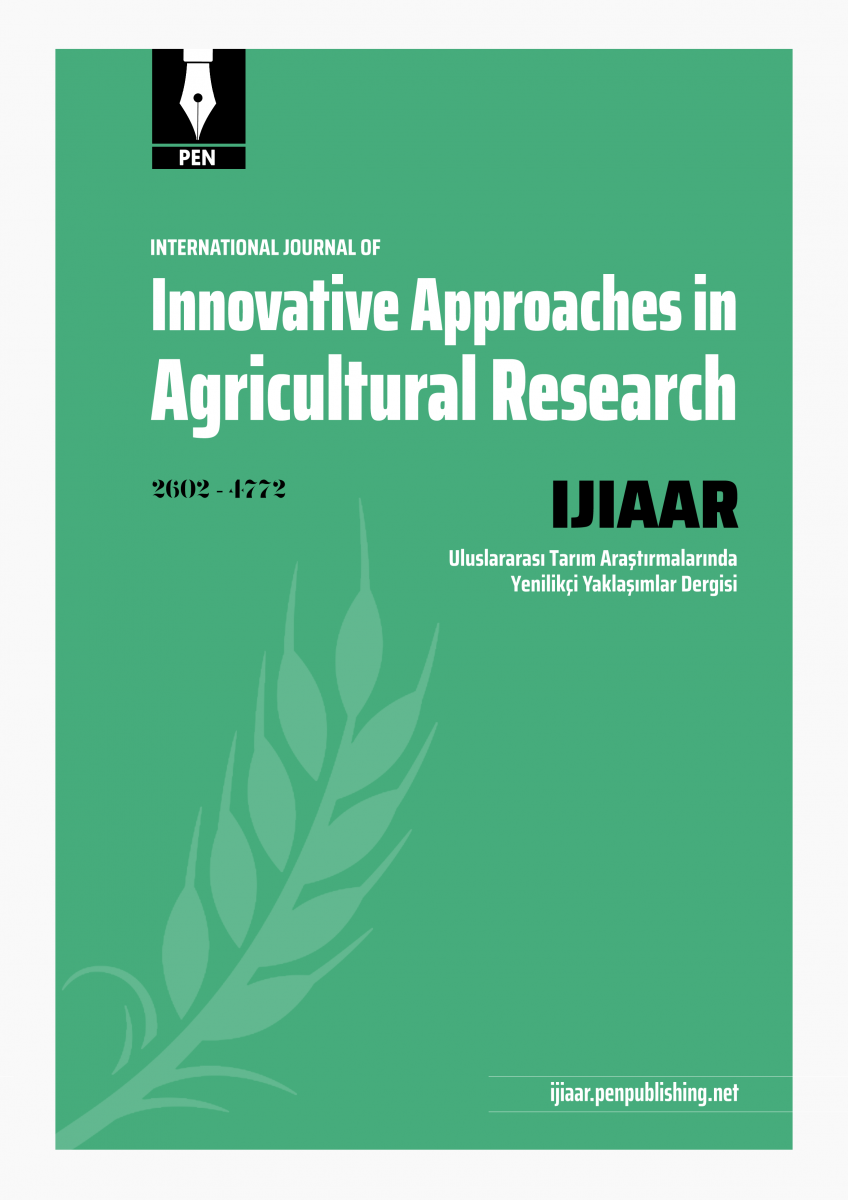- Atalay, E., M. Yorgancilar and M.T. Erenkoyuncu (2016). Organik bitkisel üretimi. Yorgancilar, M. [Ed]. Organik Tarım. Atlas Akademi. Konya, Turkey, 11-37. [Google Scholar]
- Bailey, K.L. and G. Lazarovits (2003). Suppressing soil-borne diseases with residue management and organic amendments. Soil Tillage Res., 72, 169-180. [Google Scholar]
- Campaglia, E., R. Manchinelli, E. Radicetti and F. Caporali (2010). Effect of cover crops and mulches on weed control and nitrogen fertilization in tomato (Lycopersicon esculentum Mill.). Crop Protect., 29, 354-363. [Google Scholar]
- Chozin, M.A., J.G. Kartika and R. Baharudin (2014). The Use of Arachis pintoi as biomulch in tomato cultivation. J. Hort. Indonesia, 4(3), 168-174. [Google Scholar]
- Chozin, M.A., F.I. Nuryana, D. Guntoro, A. Sumiahadi, R.N. Badriyah and A.P. Wibowo (2018). Potency of Arachis pintoi Krap. & Greg. as biomulch in the tropical upland agriculture. IOP Conf. Ser.: Earth Environ. Sci., 196, 012011. [Google Scholar]
- den Hollande, N.G., L. Bastiaans and M.J. Kropff (2007). Clover as a cover crop for weed suppression in an intercropping design II. Competitive ability of several clover species. Europ. J. Agronomy, 26, 104-112. [Google Scholar]
- Devi, K.M.D., C.T. Abraham and S. Krishnan (2013). Changes in chemical and biological characteristics of soil under long term application of herbicides in rice – rice system. Bakar B. H., D. Kurniadie and S. Tjitrosoedirdjo [Eds.]. Proc. 24th Asian-Pasific Weed Science Society Conference, 22-25 October, Bandung, Indonesia, 331-337. [Google Scholar]
- Febrianto, Y. and M.A. Chozin (2014). Pengaruh jarak tanam dan jenis stek terhadap kecepatan penutupan Arachis pintoi Karp. & Greg. sebagai biomulsa pada tertanaman tomat (Licopersicon esculentum M.). Bul. Agrohorti, 2(1), 37-41. [Google Scholar]
- Fitriana, M., Y. Parto, Munandar and D. Budianta (2013). Pergeseran jenis gulma akibat perlakuan bahan organik pada lahan kering bekas tanaman jagung (Zea mays L.). J. Agron. Indonesia, 41(2), 118-125. [Google Scholar]
- Gardner, F.P., R.B. Pearce and R.L. Mitchell (2008). Fisiologi Tanaman Budidaya. UI Press, Jakarta, Indonesia. [Google Scholar]
- Harahap, I.Y., T.C. Hidyat, Y. Pangaribuan and E. Listia (2011). Mucuna bracteata as a cultural weed control in oil palm plantation. J. Gulm. Tumb. Invasif Trop., 2(1), 35-38. [Google Scholar]
- Hiltbrunner, J., M. Leidgens, L. Bloch, P. Stamp and B. Streit (2007). Legume cover crops as living mulches for winter wheat: components of biomass and the control of weed. Europ. J. Agronomy, 26, 21-29. [Google Scholar]
- Kremer, R. and J. Li, (2003). Developing weedsuppressive soils through improved soil quality management. Soil Tillage Res., 72, 193–202. [Google Scholar]
- Linares, J., J Scholberg1, K. Boot, C.A. Chase, J.J. Ferguson and R. McSorley (2008). Use of the cover crop weed index to evaluate weed suppression by cover crops in organic citrus orchards. Hortscience, 43(1), 27-34. [Google Scholar]
- Maswar (2004). Kacang hias (Arachis pintoi) pada usahatani lahan kering. Balai Benelitian Tanah, Jakarta, Indonesia, http://balittanah.litbang.deptan.go.id. Date accessed: 10 March 2013. [Google Scholar]
- Ngouajio, M. and H. Mennan (2005). Weed populations and pickling cucumber (Cucumis sativus) yield under summer and winter cover crop systems. Crop. Prot., 24, 521-526. [Google Scholar]
- Nusyirwan (2012). Potensi penutup tanah Mucuna bracteata di bawah tanaman karet. J. Gulm. Tumb. Invasif Trop., 3(1), 39-42. [Google Scholar]
- Perez-Nieto, J., E. Valdes-Velarde, M.E. Hernandez-San Roman and V. Ordaz-Chaparro (2005). Rain, runoff, and soil erosion in shaded coffee agroforestry systems. Agrociencia, 39, 409–418. [Google Scholar]
- Pullaro, T.C., P.C. Marino, D.M. Jackson, H.F. Harrison and A.P. Keinath (2006). Effect of killed cover crop mulch on weeds, weed seeds and herbivores. Agric. Ecosys. Environ., 115, 97-114. [Google Scholar]
- Purba, E.R. Nababan and T. Simanungkalit (2011). Three populations of barnyard grass in North Sumatera resistant to metsulfuron methyl. J. Gulm. Tumb. Invasif. Top., 2(1), 28-30. [Google Scholar]
- Reberg-Horton, S.C., J.D. Burton, D.A. Danehower, G. Ma, D.W. Monks, J.P. Murphy, N.N. Ranells, J.D. Williamson and N.G. Creamer (2005). Changes over time in the allelochemical content of ten cultivars of rye (Secale cereale L.). J. Chem. Ecol., 31, 179–193. [Google Scholar]
- Rice, P.J., L.L. McConnell, L.P. Heighton, A.M. Sadeghi, A.R. Isensee, J.R. Teasdale, A.A. Abdul-Baki, J.A. Harman-Fetcho and C. Hapeman (2001). Runoff loss of pesticides and soil: a comparison between vegetative mulch and plastic mulch in vegetable production systems. J. Environ. Qual., 30, 1808–1821. [Google Scholar]
- Ruegg, W.T., M. Quadranti and A. Zoschke (2007). Herbicide research and development: challenges and opportunities. Weed Res., 47, 271–275. [Google Scholar]
- Samad, S., M. Mustafa, Baharuddin and A. Rampisela (2009). Optimalisasi produksi kentang ramah lingkungan di Parigi Kecamatan Tinggi Moncong Kabupaten Gowa. J. Sains dan Teknol., 9(1), 36-43. [Google Scholar]
- Santos, J.C.F., A.J. da Cunha, F.A. Fereerira, R.H.S. Santos, N.S. Sakiyama and P.C. de Lima (2013). Cultivation of perennial herbaceous legumes in weed management in coffee plantation on the Cerrado. J. Agric. Scie. Technol., 3, 420-428. [Google Scholar]
- Sumarni, N., E. Sumiati and R. Rosliani (2009). Respon tanaman mentimun terhadap penggunaan tanaman penutup tanah kacang-kacangan dan mulsa jerami. J. Hort., 19(3), 294-300. [Google Scholar]
- Sumiahadi, A., M.A. Chozin and D. Guntoro (2016). Evaluasi pertumbuhan dan perkembangan Arachis pintoi sebagai biomulsa pada budidaya tanaman di lahan kering tropis. J. Agron. Indonesia, 44(1), 98-103. [Google Scholar]
- Tampubolon, B.H. (2004). Pertumbuhan dan hasil tanaman jagung yang ditumpangsarikan dengan Calopogonium caeruleum Hemsl. disertai pemupukan nitrogen. Bul. Agron., 32(1), 13-19. [Google Scholar]
- Taufik, M., A. Khaeruni, A. Wahab and Amiruddin (2011). Agens hayati dan Arachis pintoi memacu pertumbuhan tanaman lada (Piper nigrum) dan mengurangi kejadian penyakit kuning. Menara Perkebunan, 79(2), 42-48. [Google Scholar]
- Teasdale, J.R (1995). Influence of narrow row/high population corn (Zea mays) on weed control and light transmittance. Weed Technol., 9, 113–118. [Google Scholar]
- Wagger, M.G. (1989). Cover crop management and nitrogen rate in relation to growth and yield of no-till corn. Agron. J., 81, 533-538. [Google Scholar]
- Yavuz, R., M. Esmeray and V. Urin (2017). The effect of some herbicides on maize and weed biomass. Journal of Bahri Dagdas Crop Research, 6(2), 1-6. [Google Scholar]
- Zhilmdahl, R.L. (2007). Fundamentals of Weed Science 3rd Edition. Elsevier, London, UK. [Google Scholar]
|

